
Chapter 7: Unusual Features (2/2)
 |
[221] FIGURE 235 [left].- Several extraordinary, tiny, puckered, collapse depressions (arrows) are in this detailed view of a very small area of western Mare Serenitatis. The collapse depressions are distinctly different from the many normal craters in this picture. One normal crater contains two clusters of the depressions. Such depressions are known nowhere else on the Moon; their closest analog is the odd but very much larger feature shown in figures 232 and 233. The collapse depressions here are much fresher and younger than the cratered lavas in which they occur. In fact, they must be among the youngest nonimpact features on the Moon. How the collapses occurred is an intriguing puzzle. Were they formed by the recent escape of gas from beneath the surface?-K.A.H.
|
|
| |
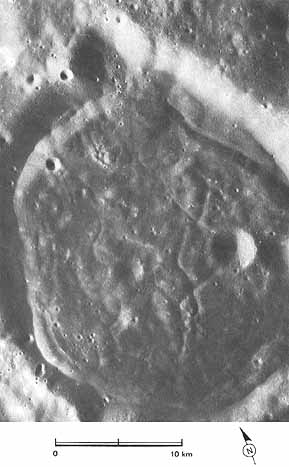 |
FIGURE 236 [left].- A panoramic camera view of an unusual crater on the lunar far side, west of the large crater Aitken. The crater is polygonal in outline, its rim is not raised, and its walls are relatively smooth. The floor of the crater is occupied by a rather dark material with numerous cracks. This pattern has been informally referred to as a turtleback crater floor (El-Baz and Roosa, 1972). It occurs only in a few craters on the lunar surface and is probably caused by the cooling of a molten or partially molten fill within the crater. However, cracking due to tectonic movement (for example, the upward thrust of a central plug) cannot be excluded.-F.E.- B.
|
[222] FIGURE 237 [below].- A view looking south into a small 19-km diameter crater southwest of Mandel'shtam on the lunar far side. The crater has a floor that is heavily lineated and grooved, but this structure is subdued rather than sharp and is contained wholly within the crater. The cracked floor is typical of a variety of craters that occur in the highlands away from the mare basins. They differ from cracked floor craters, such as Humboldt, and rilled craters, such as Goclenius; their origin is unknown.- J.W.H.
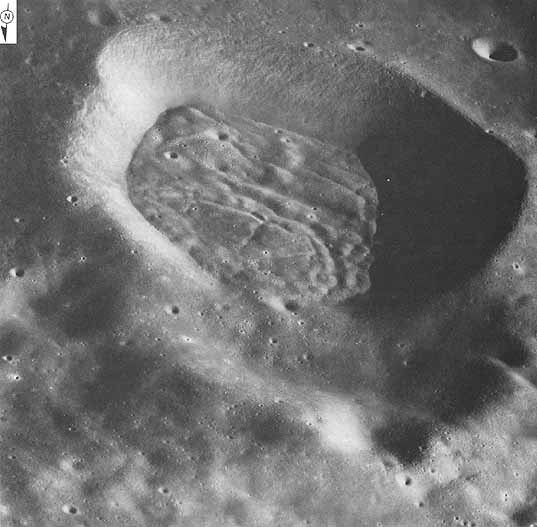
|
[223] |
 |
FIGURE 238 [above].- The obvious peculiarity of this crater is its shape, the causes for which are open to speculation. The entire area pictured is in the floor of the 60-km-diameter crater Barbier, located on the lunar far side and centered at 23.9° S, 157.7° E. Barbier is a relatively old crater, and the high density of craters on its floor is evident in this high-resolution photograph from the Apollo 15 panoramic camera. The two angular corners of the oddly shaped crater suggest that its present form is partly controlled by faults or joints in the floor of Barbier. The slightly raised rim of the crater evidenced in the shadow on the rim at the left and the brightening on the rim in the lower right side of the crater-shows that material was ejected from the crater at the time of its formation and that it is not simply a collapsed portion of the floor of Barbier. The long dimension of the pictured crater is 16 km, and the short dimension is 10 km.-M.C.M.
|
[224] |
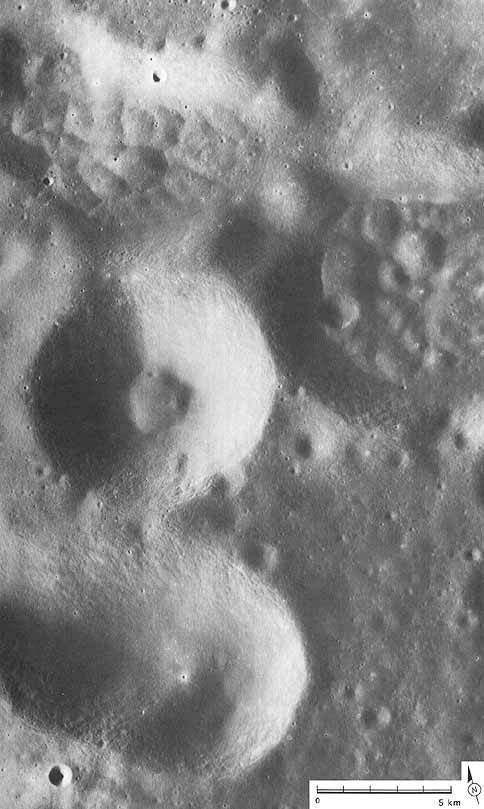 |
[225] FIGURE 239 [above].- The four large depressions in this photograph are part of a cluster of secondary impact craters on the floor of Gagarin, a large (275-km-diameter) crater on the far side of the Moon. The secondaries pictured here lie close to Gagarin's northeastern rim. Mapped as pre-Nectarian in age (Stuart-Alexander, 1976), Gagarin is filled with relatively bright plains-forming deposits. The plains deposits are probably about I km thick; Gagarin was originally about 4 to 5 km deep.
Of particular interest in this photograph are the peculiar bumpy floors of the two craters nearest the upper right corner of the photograph. Several other craters in this part of Gagarin have the same morphology. The rounded hills or bumps, I/z to 2 km across, fill the crater floors so that the craters are shallower than is normal for craters of their size and age. For example, the center crater of the four is now the deepest, yet the two eastern ones are as wide or wider and, therefore, should be at least as deep.
A possible explanation for both the surface morphology and the raised floor level of the two eastern craters may be related to the intrusion of magma into the brecciated materials that probably occurred on the floors of these craters. It is known that the bottoms of freshly formed impact craters of this size often contain a deposit of low- density fragmental material. Even though areas of mare material are quite limited on the far side of the Moon, it is reasonable to assume that mare-basalt magma underlies the subsurface in this section of the floor of Gagarin. Mare lava, for example, is exposed in the floor of a larger (90-km-diameter) crater on the west rim of Gagarin. (See fig. 240.) The fracture system associated with the inner walls of a large crater is a likely conduit along which magma may rise and then intrude into the weakest strata. Because the floors of impact craters consist of low-density fragmental material, any crater on the floor of Gagarin, situated near its walls, may have served as a locus for magmatic intrusion. As lunar mare magma rose through the subsurface from a zone of melting at depth and reached the debris in the two crater floors, it may have lifted the debris and fractured it into segments l/2 to 2 km across. Surficial fragmental debris from the uplifted segments then drained into the cracks between them to produce the bumpy, rounded topography. The low-density segments would tend to "float" at the same general level on the underlying denser magma, with the largest segments standing highest. The relative amount of uplift of materials in the craters in this photograph correlates both with the original depth of the craters (inferred from their diameters, which are proportional to depth) and with their proximity to the wall of Gagarin, which is located about 1 1/2 km inside the northeastern corner of the picture. Correlation with crater depth suggests that the magma intruded under the deepest crater because the roof was thinnest there and offered the least resistance. Correlation with proximity to Gagarin's wall indicates that the inferred fracture zone near the wall provided a locus for easier subsurface flow and better subsurface plumbing for the upwelling magma. The bumpy material in the northwest depression stands highest of all. Although it was neither the deepest nor the nearest to Gagarin's wall, it may have been centered over the contact between Gagarin's original floor material and the wall and thus been a locus for intrusion. Subsurface flow from the largest (northeastern) depression into the northwestern one may have contributed to uplift of the latter depression; the hill forming the septum between them is the largest uplifted block in the cluster and indicates that intrusion took place under the septum.-R.E.
[226] FIGURE 240 [below].- This photograph shows part of the floor and walls of the largest (90 km) crater inside the old pre-lmbrian crater Gagarin on the far side of the Moon. The 90-km crater is partly filled with relatively dark, young mare materials and contains the circular depression shown here. The depression is about 4 km in diameter and has a very low raised rim or none at all. Rock layering and narrow terraces along resistant layers are visible. The floor of the depression and the adjacent mare surfaces have an equal density of craters, suggesting that they are the same age.
Morphological evidence supports the hypothesis that the depression was formed by collapse of the mare materials. Two narrow and shallow rilles debouch high on the west and east depression walls; they are interpreted as lava tubes that originated under the depression before it collapsed. This interpretation is further supported by the mare ridge, which extends down the south wall onto the depression floor. A dome adjacent to the ridge on the floor may also record late volcanic activity in the depression.-M.J.G.

|
[227] |
 |
FIGURE 241 [above].- This crater (approximately 9 km across) is on the juncture between two basalt units at the south border of Mare Serenitatis. The unit south of the dashed line forms a conspicuous dark border around the mare and slopes northward toward the center of the Serenitatis basin. The adjacent mare unit is lighter in color, generally flat, and embays the older dark unit. The straight rille grazing the crater is one of several concentric grabens in the dark border material and probably formed by extension as the lava sagged toward the basin center prior to emplacement of the central mare. The crater is largely filled by the younger mare unit; because the graben transects the crater rim and its trend is influenced by the crater, the graben is probably younger. C.A.H.
 |
[228] FIGURE 242 [left].- This picture, showing an area in central Mare Serenitatis 200 km from the nearest outcrops of terra rocks, is an oblique view of a 4-km diameter crater form about 200 m deep. The crater floor is similar to the surface of the surrounding mare, which is presumably mare basalt covered by 3 to 6 m of regolith. The rim of the crater is raised, although subdued; from this we infer that the present form was developed when mare lava flooded a normal impact crater that had formed on a lower, preexisting surface. The flooding basalt then subsided, more or less in proportion to its thickness, which was greatest inside the crater. The subsidence may have resulted from escape of bubbles from the lava while it was soft, thermal contraction of the lava, and compaction of an underlying relatively loosely packed regolith. Regolith compaction may have occurred when the load and heat of the flooding lava crushed irregular fragments of regolith into more compact shapes and plastically deformed the glassy components of the regolith into more compact shapes or into voids between other particles. R. J. Pike's (1972) data on the rim heights of lunar craters 90 m to 10 km in diameter indicate this crater probably had a rim about 200 m high when it was buried. The lava plain around the depression presently stands about 25 m below the rim crest, giving a minimum thickness for the flooding lava of 175 m.-R.E.E. |
|
| |
 |
FIGURE 243 [left].- This rimmed depression draped by mare lava is at the end of a mare ridge segment due north of Copernicus in Mare Imbrium. The unusual shape of the crater may indicate a volcanic origin; alternatively, a circular or elliptical impact crater may have been deformed by subsequent development of the mare ridge, a part of which impinges on the crater at the northeast side. In any case, a preexisting rimmed depression seems to have been buried by mare, reappearing as a mantled structure upon solidification and compaction of the lava.-C.A.H.
|
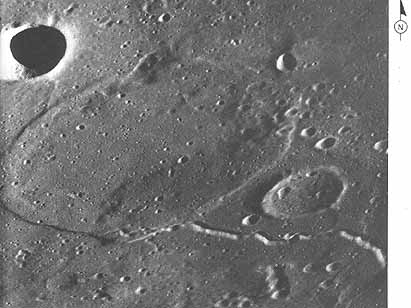 |
[229] FIGURE 244 [left].- This oblique photograph shows the buried crater Jansen R in northern Mare Tranquillitatis. This crater is about 25 km across, and empirical relationships between crater diameter and crater depth indicate that the mare basalt cover may be several kilometers thick. The rille in the right foreground may have been formed by the collapse of a lava tube.-D.H.S.
|
|
| |
|
FIGURE 245 [right].- The elongate crater Torricelli near the north margin of Mare Nectaris was probably formed by two simultaneous impacts as indicated by the partly developed septum at A. The overlapping clusters of small craters at B, C, and elsewhere around the rim were made by secondary impacts of ejecta from the large crater Theophilus more than 150 km to the southwest. D.H.S.
|
 |
[230] FIGURE 246 [below].- This small unnamed crater in Mare Cognitum is unusual because it appears to be deformed by a fault that also bounds a mare ridge. About 5 km in diameter, the crater is obviously older than the mare materials that have buried the outer part of its ejecta blanket. The visible part of the fault extends between the arrows and clearly transects the western wall of the crater. It also marks the west flank of a small mare ridge north of the crater. Viewed stereoscopically, the fault plane can be seen to dip gently to the west, and the surface west of the fault is lower than that on the east. The fault is, therefore, a low-angle normal fault. The abrupt disappearance of the fault at the south rim of the crater may seem surprising. One of several explanations is that it may lie buried beneath a younger basalt flow that flooded the area immediately south of the crater. Many lunar investigators, including several contributors to this volume, have suggested a relationship between faulting and the development of mare ridges. Although this is a very small and certainly uncommon example, it is a convincing example of a mare ridge that is coincident with a fault and thus lends support to this idea.-G.W.C.
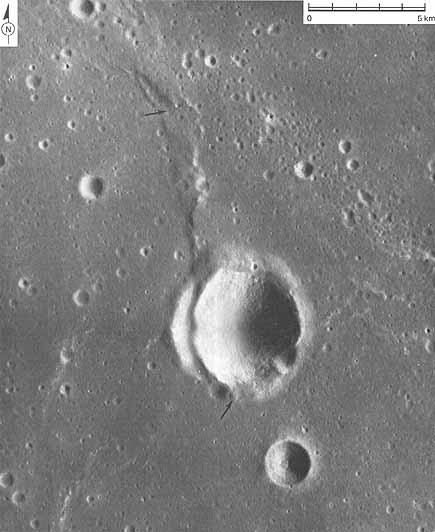
|
[231] |
 |
FIGURE 247 [above].- Bright swirls in and around Mare Marginis on the eastern limb of the Moon. These peculiar markings that are characterized by very high albedo and sinuous outlines are not fully understood. In this particular field (El-Baz, 1972a) the swirls occur in all types of geomorphologic units: They abound in the dark and flat material of Mare Marginis, but they occur also in highland units. A good example of this occurrence is to the southeast of the crater Al-Biruni, upper middle of the photograph. The small fresh crater on the rim of Goddard (center of photograph) cannot be the cause of these swirls that extend far beyond the area shown.
This author previously indicated that the area is antipodal to the location of the Orientale basin on the west limb of the Moon. It is probable that the formation of the Orientale basin is responsible for these bright swirls-either by the meeting of fine ejecta at the antipodal point or by surface disturbance due to seismic waves traveling at or near the surface also meeting on the opposite side of the impact point. The origin of these swirls, however, is still open to discussion.-F.E.-B.
Alternate explanations for the swirls are based on the observations that they have no relief of their own and the crater density within the swirls is similar to surrounding areas. They may represent surface alteration products formed by gases that have escaped from the lunar interior or by some poorly understood process of ejecta deposition. Interaction with the extralunar environment may also have played a part in the development of the swirls.-J.W.H.
| Next |